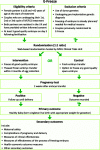Study protocol: E-freeze - freezing of embryos in assisted conception: a randomised controlled trial evaluating the clinical and cost effectiveness of a policy of freezing embryos followed by thawed frozen embryo transfer compared with a policy of fresh embryo transfer, in women undergoing in vitro fertilisation
- PMID: 31196113
- PMCID: PMC6567605
- DOI: 10.1186/s12978-019-0737-2
Study protocol: E-freeze - freezing of embryos in assisted conception: a randomised controlled trial evaluating the clinical and cost effectiveness of a policy of freezing embryos followed by thawed frozen embryo transfer compared with a policy of fresh embryo transfer, in women undergoing in vitro fertilisation
Abstract
Background: Infertility affects one in seven couples; many of these need in vitro fertilisation (IVF). IVF involves external hormones to stimulate a woman's ovaries to produce eggs which are harvested surgically. Embryos, created in the laboratory by mixing eggs with sperm, are grown in culture for a few days before being replaced within the uterus (fresh embryo transfer). Spare embryos are usually frozen with a view to transfer at a later point in time - especially if the initial fresh transfer does not result in a pregnancy. Despite improvements in technology, IVF success rates remain low with an overall live birth rate of 25-30% per treatment. Additionally, there are concerns about health outcomes for mothers and babies conceived through IVF, particularly after fresh embryo transfer, including maternal ovarian hyperstimulation syndrome (OHSS) and preterm delivery. It is believed that high levels of hormones during ovarian stimulation could create a relatively hostile environment for embryo implantation whilst increasing the risk of OHSS. It has been suggested that freezing all embryos with the intention of thawing and replacing them within the uterus at a later stage (thawed frozen embryo transfer) instead of fresh embryo transfer, may lead to improved pregnancy rates and fewer complications. We aim to compare the clinical and cost effectiveness of fresh and thawed frozen embryo transfer, with the primary aim of identifying any difference in the chance of having a healthy baby.
Methods: E-Freeze is a pragmatic, multicentre two-arm parallel group randomised controlled trial where women aged ≥18 and < 42 years, with at least three good quality embryos are randomly allocated to receive either a fresh or thawed frozen embryo transfer. The primary outcome is a healthy baby, defined as a term, singleton, live birth with appropriate weight for gestation. Cost effectiveness will be calculated from a healthcare and societal perspective.
Discussion: E-Freeze will determine the relative benefits of fresh and thawed frozen embryo transfer in terms of improving the chance of having a healthy baby. The results of this pragmatic study have the potential to be directly transferred to clinical practice.
Trial registration: ISRCTN registry: ISRCTN61225414 . Date assigned 29/12/2015.
Keywords: Assisted conception; Elective freezing; Fertility; Fresh embryo transfer; Frozen thawed embryo transfer; IVF; OHSS; Receptivity.
Conflict of interest statement
The authors declare that they have no competing interests.
Figures
References
-
- NICE guidelines. Fertility: Assessment and Treatment for People with Fertility Problems [Cg156]. Accessed: [24/08/15]. Available from: https://www.nice.org.uk/guidance/cg156.
-
- Shapiro BS, Daneshmand ST, Garner FC, Aguirre M, Hudson C, Thomas S. Evidence of impaired endometrial receptivity after ovarian stimulation for in vitro Fertilization: a prospective randomized trial comparing fresh and frozen-thawed embryo transfer in Normal responders. Fertil Steril. 2011;96(2):344–348. doi: 10.1016/j.fertnstert.2011.05.050. - DOI - PubMed
-
- Shapiro BS, Daneshmand ST, Garner FC, Aguirre M, Hudson C, Thomas S. Evidence of impaired endometrial receptivity after ovarian stimulation for in vitro Fertilization: a prospective randomized trial comparing fresh and frozen-thawed embryo transfers in high responders. Fertil Steril. 2011;96(2):516–518. doi: 10.1016/j.fertnstert.2011.02.059. - DOI - PubMed
Publication types
MeSH terms
Grants and funding
LinkOut - more resources
Full Text Sources
Medical



